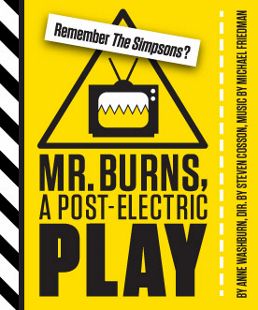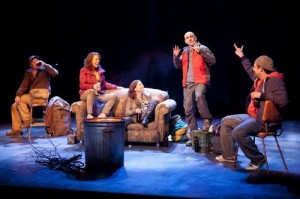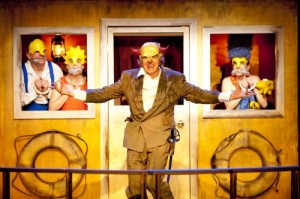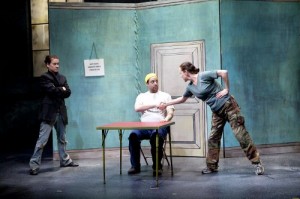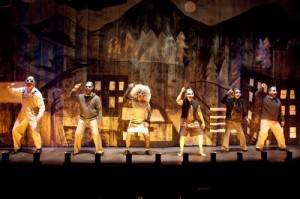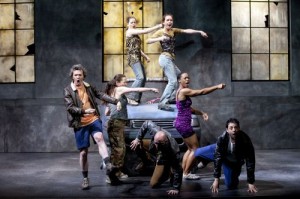I WILL SURVIVE
In the opening act of Mr. Burns, A Post-Electric Play, a group of campers sits by the warm glow of a trashcan fire and tries to retell a favorite episode of The Simpsons. Matt (the ever-energetic Steve Rosen) recalls and reperforms “Cape Feare” with entertaining accuracy. Maria (Jenna Sokolowski) and Jenny (Kimberly Gilbert) chime in with a few lines and impersonations, goading on Matt’s storytelling when he falters. No doubt the audience could contribute their own recollections of Sideshow Bob’s attempts to murder Bart in this iconic episode.
Yet something is wrong with this picture. Why are these campers sitting on a weathered couch in the great outdoors? Why is Sam (James Sugg) on guard duty? Why is Colleen (Amy McWilliams) hunched to the side, hesitant to engage with the group? Bit by bit, the grim reality falls into place. A nuclear disaster has wiped out much of the United States’ population, and the few survivors have created tenuous alliances with one another for provisions and protection, comfort and companionship. Mr. Burns, A Post-Electric Play is a compelling exploration of storytelling as an essential mode of human survival.
For playwright Anne Washburn, pop culture is a lens through which we navigate our collective history. More to the point, pop culture is our history. Act I of Mr. Burns may begin with a seemingly sharp dividing line between fiction and reality – The Simpsons and nuclear catastrophe – but the stories become inextricably intertwined. In Act II, which takes place seven years after the disaster, the group of survivors has become a professional theater company that performs Simpsons episodes (including the commercials!)for nostalgic audiences. In Act III, seventy-five years later, “Cape Feare” has transmuted into an operatic myth of origins for the post-electric civilization. Nuclear power plant owner Mr. Burns has replaced Sideshow Bob as the archetypal villain – and Bart (Erika Rose) has become the triumphant hero. Washburn’s smart three-act structure progresses from primitive campfire storytelling to rehearsal to staged performance, tracing a cultural myth across its stages of construction.
The Simpsons is not the only cultural reference to be written (and rewritten) into this new civilization’s mythology. The “Cape Feare” episode alone spoofs the 1962 film Cape Fear and its 1991 remake while alluding to other horror films, Gilbert and Sullivan operettas, Matlock and more. Washburn’s postmodern script draws on a wide range of cultural references, particularly in collaboration with composer Michael Friedman. Friedman’s playful pastiche score mashes up popular music from Britney to Eminem, as well as The Simpsons theme and the ominous horn blares of the “Cape Feare” episode. (These four notes happen to be misremembered in Act I and continue to be misremembered throughout the play – a brilliant touch.) Like Washburn’s story, Friedman’s music subtly transforms over time with new orchestrations and arrangements, altered lyrics and narrative contexts. Friedman’s masterful Act III opera manages to be at once familiar and strange, intertwining tropes of operetta, musical theater, rap, and pop into a decidedly new musical drama. Jonathan Tuzman deserves particular recognition for his tight music direction and graceful transitions from one instrument to another; he is the play’s only musician, but the soundscape never feels thin.
Like Friedman’s music, Diane Coburn Bruning’s choreography transforms across time, from energetic dance routines – almost direct citations of the original music videos – to more stylized adaptations of the familiar movement. The ensemble thrives under the sharp direction of Steve Cosson, whose pacing strikes a balance between the wonderfully silly Simpsons and the profound questions provoked by this pop cultural icon after the apocalypse. At the heart of Act II, for instance, Gibson (a gripping Chris Genebach) collapses into the arms of a fellow cast member out of frustration that Mr. Burns is never featured in the theater company’s repertoire. Beneath the surface of his pop culture crisis, Gibson actually mourns the fact that the survivors of the nuclear disaster cannot yet deal with their own nuclear villain. Could a story help heal the wounds?
Mr. Burns, A Post-Electric Play is another triumph in The Civilians’ unique brand of investigative theater, creatively crossing fact and fiction to grapple with how our culture is constructed – and how it might be reconstructed in the wake of a crisis. By the end of the performance, Mr. Burns has become part of the audience’s own repertoire: a story to share and a story to survive. Hopefully The Civilians will have the opportunity to retell this tale to another enthralled audience in the near future.
photos by Scott Suchman
Mr. Burns, A Post-Electric Play
The Civilians
Woolly Mammoth Theatre Company in Washington, D.C.
ends on July 1, 2012
for tickets, visit Woolly Mammoth
